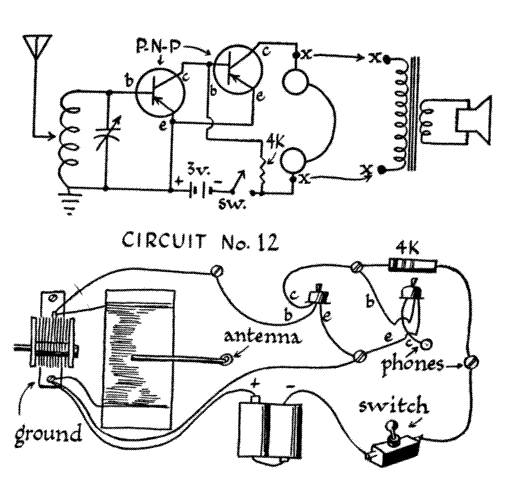The point contact transistor was as the
name says a slab of material with some cat whiskers pressing against
it. In order to 'toughen' it up the junctions were 'formed'. The
forming process was to put a controlled high current through it. The
heat generated and the current flow would mobilize the molecules.
They would diffuse into the structure and form the junction. This
process was a GOD send to the developer because they had difficulty
making it happen. The material used in the first transistor worked at
very low temperatures. Once the proof of concept was produced the
research went exponential. The next step was to apply a small bead of
dopant to the cats whisker and fuse it to form the junction. Gallium
was a good choice in the early development because it has a melting
point of about 86 degrees F and Gallium will dissolve Germanium. When
you solder a copper wire the solder will 'wet' the surface of the
copper and form a bond. The Gallium does much the same with
Germanium. While this worked and gave hope of the devices working it
was also very fragile. You can take the point contact transistor in
your hand a pluck the lead like a guitar string and it is ruined. You
can solder a point contact without a heat sink and you ruined it.
They would come wrapped in foil or with a little o ring on the leads
to prevent vibration. They also come with long leads to allow the use
of heat sink and stress relieve in the design. The researchers were
trying to build a field effect transistor. Some say they were 90%
succeeded. The point contact act more like a FET than a modern
silicon transistor. That's good news for us because they just want to
work for us. Here are some of the earliest designs.
You can build this circuit with a
single AAA battery and replace the 2K headset or with a piezo ear
piece and a 2K resistor and have a working radio.
Here is a two transistor radio you
could build.

The small part count is what makes
these radio a mystery today. The modern circuit would be temperature
compensated and would have a precise biasing design and etc. Because
they did work as well as they do the researchers moved forward and we
have the modern micro systems otherwise we would still be using
vacuum tubes!
Long time ago I built one of these in a
Prince Albert tobacco tin. It would work without any ground other
than me as I was holding the can or carrying it in my shirt pocket.
I guess the next best thing would be an altoid tin.
This is what's inside the little round can. The cat whiskers are 'pre tinned' with gallium. The gallium dissolves the germanium when heated and the diffusion junction is formed. The second or third generation tranny. As can be seen the only difference between the emitter and collector is the size of the blob of dopant. These diffused junction transistors could be reversed in the circuit and still function. when you study some of the old circuits it may seem they are biased incorrectly for this reason.

No comments:
Post a Comment